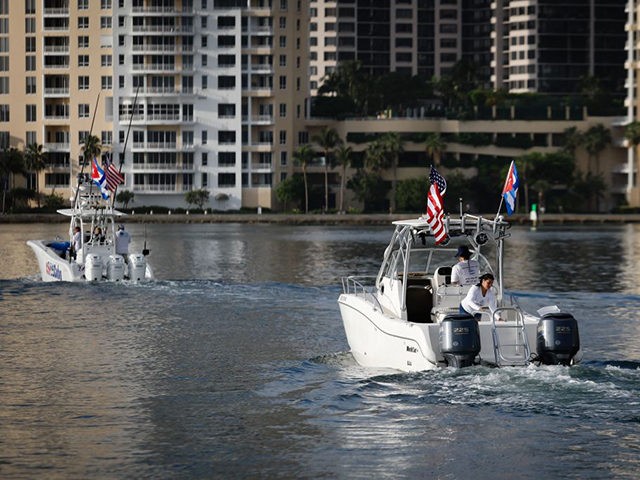A flotilla organized by Cuban-Americans will depart Florida on Friday to international waters as close to Cuba as possible in a show of solidarity and support for anti-communist protesters on the island.
Protests have persisted for nearly two weeks since thousands of Cubans marched in the streets of nearly every major city in the country on July 11. Protesters throughout the country chanted anti-government slogans and called for an end to the 62-year-old communist regime; no reports indicated that any protesters engaged in violence against state actors or that any were armed. The Communist Party’s response to the protests, however, has consisted of mass arrests and forced disappearances, brutal beatings and shootings of protesters, and an ongoing internet shutdown that has incapacitated journalists and human rights groups working abroad to document the resistance to communism.
Outside of Cuba, the Cuban exile diaspora has organized protests throughout the United States and abroad, urging Washington to act to save the lives of persecuted protesters. The largest protests have occurred in Florida, home to the largest Cuban-American population in the country, and Washington, D.C., where a consistently large group has remained camped outside the White House urging President Joe Biden to act against the regime.
The Miami flotilla was scheduled to leave the city on Friday morning for Key West, where it plans to refuel before taking off into international waters. Osdany Veloz, who organized the effort, said the group was actively working with the U.S. Coast Guard to ensure that it fulfills its mission of making itself visible to Cubans — a sign that the Cuban diaspora is with them in spirit — safely and legally.
Veloz told Miami’s AmericaTeVe that the Coast Guard sternly warned the boat owners that they could not bring any weapons — as Cuban protesters are unarmed and victims of extreme state violence, the diaspora has openly called for a legal way to arm Cubans on the island — and that it would be illegal for them to rescue anyone if Cuban nationals attempt to approach their vessels.
“They simply told us not to cross [into Cuba]. Another restriction is, unfortunately, if someone takes to the sea, we can’t rescue them, we can’t put them on our boats,” Veloz explained. “It’s something very difficult. I don’t want to see it, I don’t want to see that situation.”
Veloz added the group intends to use flares and fireworks to make themselves known to Cubans without violating the nation’s sovereign waters.
The Department of Homeland Security (DHS) issued a scolding statement last week reminding Cuban-Americans that any attempt to help Cuban balseros, or “rafters,” leave the country would be subject to intense criminal punishment. The statement was notably more stern than the agency’s typical treatment of migrants attempting to cross the southern land border of the United States and the human traffickers enabling the practice.
“Vessels and persons illegally entering Cuban territorial waters … or departing from U.S. territorial waters with the intention of entering Cuban TTW without the required permit may be subject to seizure of their vessel,” DHS warned, “civil and criminal penalties up to $25,000 per day, and 10 years in prison.”
“People who violate U.S. immigration laws and illegally bring foreign nationals into the country or who attempt to do so may be subject to arrest, vessel forfeiture, civil and criminal fines up to $250,000 per day, and five years in prison,” the statement concluded.
Cuban-Americans have for decades organized efforts using the proximity of the island to attempt to make statements in favor of human rights and send humanitarian aid, often placing themselves in the line of danger. The Castro regime has committed multiple massacres outside of its own territorial waters, including against American citizens. In 1996, the Cuban government killed four American citizens flying planes in international waters. The men belonged to Brothers to the Rescue, a group dedicated to finding rafters in danger floating in the Straits of Florida and helping them to safety. At the time, U.S. laws allowed for the rescue of Cubans at high seas; President Barack Obama rescinded that policy.
Despite the fact that the four killed were Americans and that they had not committed any crime or violated any border, the administration of then-President Bill Clinton did nothing in retaliation for their murders. Obama freed the one person imprisoned for helping the Castro regime execute the murders – Gerardo Hernández Nordelo, a communist spy known as a member of the “Cuban Five” network sent to infiltrate dissident groups. Hernández is now the leader of the Committees for the Defense of the Revolution (CDRs), communist neighborhood espionage networks that help the regime terrorize and disappear political dissidents.
The most famous Cuban-American solidarity flotilla organized in recent memory is the Movimiento Democracia effort, which began in the 1990s and sought to send food and medicine to Cuba. The little remaining pillars of the U.S. “embargo” on Cuba do not ban humanitarian aid, but communist Cuban laws do limit how much aid Americans can send. The movement sent a vessel full of soap, food, and other humanitarian supplies in 1998, the first such major effort since the Brothers to the Rescue murders, according to the Associated Press at the time.
Ramón Saúl Sánchez, the founder and head of the Movimiento Democracia, came to see the Cuban solidarity flotilla off from Miami on Friday, according to the Washington Post. Sánchez, who has struggled against deportation attempts for years, reportedly warned the group not to make itself too conspicuous lest the Castro regime attack them.

COMMENTS
Please let us know if you're having issues with commenting.